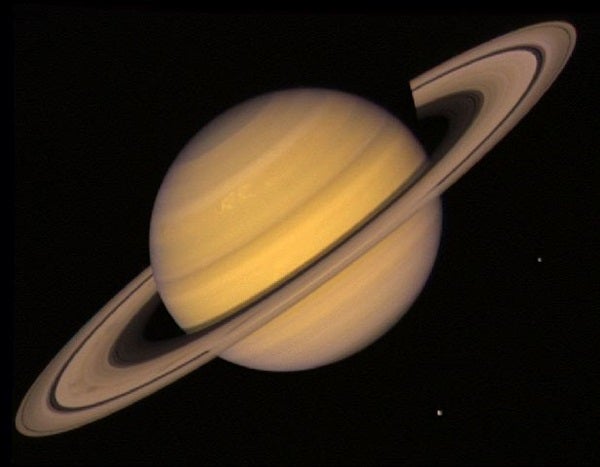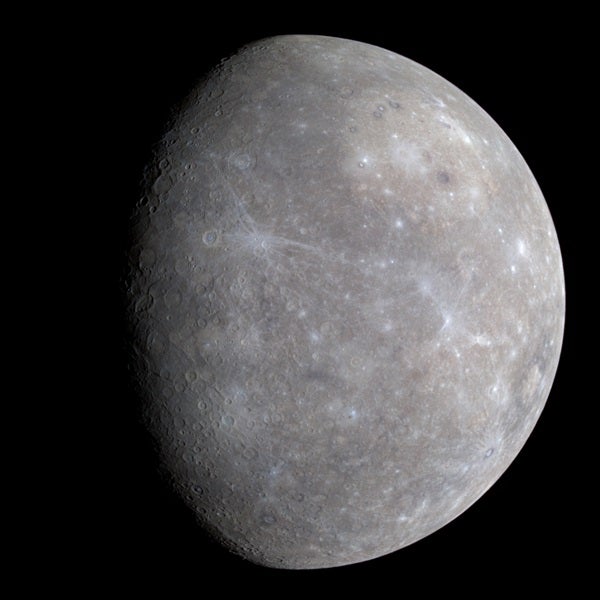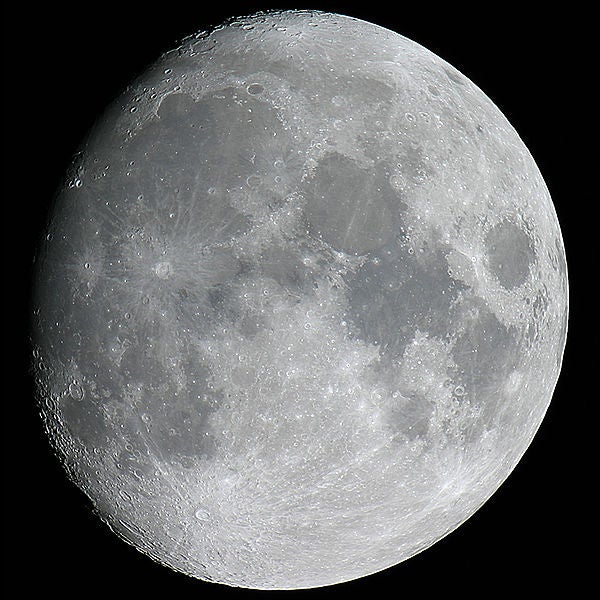Friday, June 10
• Magnificent Saturn reached its peak just a week ago, when it appeared opposite the Sun in the sky, and our view of the ringed planet remains spectacular. It is on display nearly all night among the background stars of southern Ophiuchus, hanging in the southeastern sky as darkness falls and climbing high in the south by midnight local daylight time. Saturn continues to shine brightly, too, at magnitude 0.0. When viewed through a telescope, the dramatic ring system spans 42″ and tilts 26° to our line of sight, while the planet’s family of moderately bright moons appears next to the gorgeous world.
Saturday, June 11
• A half-lit Moon hangs about 4° to Jupiter’s left in this evening’s sky. The pair becomes visible within a half-hour after sunset (though the Moon shows up in the daytime sky during the afternoon) and remains on view until 1 a.m. local daylight time. The Moon officially hits First Quarter phase at 4:10 a.m. EDT tomorrow morning.
Sunday, June 12
• Mars remains near its peak all this week. The Red Planet reached opposition on May 22 and made its closest approach to Earth (at a distance of 46.8 million miles [75.3 million kilometers]) on the 30th. Mars appears in the southeastern sky as darkness falls and grows more prominent as the evening wears on and it climbs higher. By 11 p.m. local daylight time, it stands one-third of the way to the zenith in the south against the backdrop of southern Libra. The world shines at magnitude –1.8, just a hair dimmer than the brightest point of light in the sky, Jupiter. When viewed through a telescope, Mars’ orange-red disk spans 18″. Look for subtle dark markings along with a whitish north polar cap.
• For people who live near 35° north latitude, today marks the earliest sunrise of the year. Although the Northern Hemisphere’s longest day doesn’t occur until Earth’s summer solstice on June 20, earliest sunrise happens several days before and latest sunset several days after. The specific dates depend on your latitude, however. In general, earliest sunrise occurs closer to the solstice the farther north you live.
Monday, June 13
• Brilliant Jupiter appears high in the southwest as darkness falls and remains on display until 1 a.m. local daylight time. The giant planet shines at magnitude –2.0 — 0.2 magnitude brighter than Mars blazing in the southeast — against the backdrop of southern Leo the Lion. Jupiter appears equally dazzling through a telescope, which reveals a wealth of atmospheric features on a disk that spans 36″. Although such detail appears on every clear evening, a rare treat awaits observers tonight when two moons disappear within minutes of each other. Early this evening, Io and Ganymede both lurk near Jupiter’s western limb. Ganymede passes behind the limb at 12:35 a.m. EDT with Io following 10 minutes later.
Tuesday, June 14
• Neptune’s eastward motion against the background stars comes to a halt at 4 a.m. EDT. This so-called stationary point marks the beginning of the best period to observe an outer planet. Neptune rises around 1 a.m. local daylight time and appears nearly 30° high in the southeast as morning twilight commences. The magnitude 7.9 planet lies in Aquarius, some 0.5° southeast of 4th-magnitude Lambda (l) Aquarii, and doesn’t move noticeably all week. You’ll need binoculars to spy Neptune and a telescope to see its blue-gray disk, which spans 2.3″.
Wednesday, June 15
• Mercury shines brightly in morning twilight this week, standing 6° high in the east-northeast a half-hour before sunrise today. The inner planet shines at magnitude –0.3 and shows up easily through binoculars if you have an unobstructed horizon. When viewed through a telescope, Mercury appears 7″ across and slightly more than half-lit.
• The Moon reaches apogee, the farthest point in its orbit around Earth, at 8:00 a.m. EDT. It then lies 251,670 miles (405,024 kilometers) from Earth’s center.
Thursday, June 16
• The conspicuous Summer Triangle asterism dominates the eastern sky in late evening. Vega, the triangle’s brightest member, shines at magnitude 0.0 and stands highest of the three stars. To its lower left lies Deneb; at magnitude 1.3, it’s the faintest of the trio. Magnitude 0.8 Altair completes the bright asterism. Despite its name, the Summer Triangle appears prominent from late spring until the onset of winter.
Friday, June 17
• The waxing gibbous Moon forms the apex of a flat isosceles triangle with Mars and Saturn tonight. The Moon stands highest and about 10° from both planets; Mars and Saturn lie approximately 18° apart.
Saturday, June 18
• The Moon passes 3° due north of Saturn at 8 p.m. EDT. For observers in North America, the two appear between 3° and 5° apart throughout the night.
Sunday, June 19
• Full Moon officially arrives at 7:02 a.m. EDT tomorrow morning, but it looks completely illuminated throughout the night. It appears low in the southeast as the Sun sets and reaches its peak in the south around 1 a.m. local daylight time. For North American observers, the Full Moon crosses from Ophiuchus the Serpent-bearer into Sagittarius the Archer during the evening hours.












